Owl Babies
After reading the book ‘Owl Babies’ by Martin Waddell, the children took part in lots of owl themed activities.
They compared the different sized owls and were given the challenge of proving that the mother owl was the tallest.
They drew story maps and added labels and captions to help with their retelling of the story.
Why not ask your child to retell the story to you?
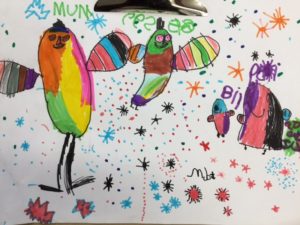
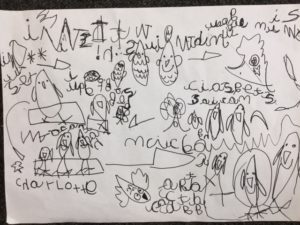

What is our new school charity?
We support our school charity for a year and it is now time to change our current school charity, Make-A-Wish.
This week, each class, discussed a range of charities, researched by the children for their homework, and voted on one charity they wanted to put forward for the school councillors to decide on.
Here were the class choices:
The final democratic decision was made by a vote by the School Council and the winning charity for 2018-2019 is WWF. We will support this charity for one year.
What makes a parachute successful?
Continuing our learning about air resistance, we decided to investigate what improved the success of a parachute. Because we had already learnt about what air resistance is and seen it in action with our running parachute, we already knew what we expected to see from our investigation.
We worked in groups, each changing one aspect of our parachute to see whether this affected how safely it brought an egg down to the ground. Each group chose what they wanted to investigate.
- material it’s made out of
- its size
- the number of parachutes
- the number of holes in the parachute
Changing the number of holes


Changing the material its made out of



We tested them by holding the bottom of the cup 1m above the floor (carefully covered by plastic bags) and dropping them. We could then see how damaged – if at all – the egg was and evaluate the success of the parachute.



We were surprised by some of our results and others were what we expected. We’re now going to discuss what we observed in class and consider why we didn’t always see what we expected – a crucial part of the scientific enquiry process.
What is a force?
This week, Year 4 have been introduced to their new mini topic – ‘Forces.’
Did you know that without forces our world would be silent and immobile?
The lessons began with the children recognising that everything on Earth is powered by forces, pushes and pulls which act on our bodies and the things around us. Forces make things move and stop moving.
Having discussed pushing and pulling, it was time to demonstrate these forces using our bodies. Working with a partner, the children created their own push and pull forces. Some were easier than others!
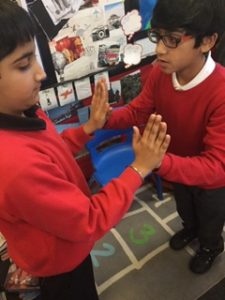
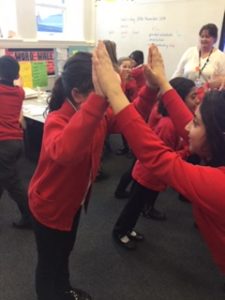
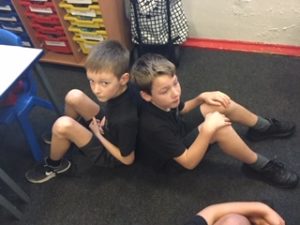
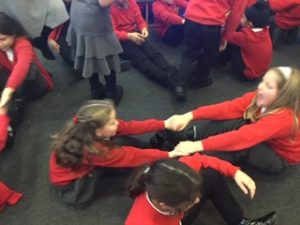
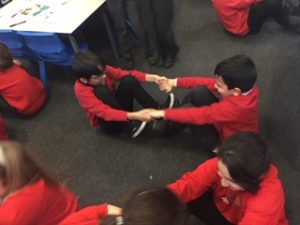
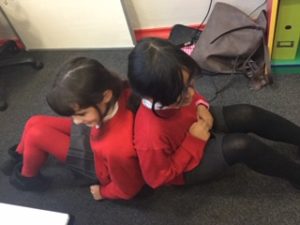
Magnetism
Magnetism is an invisible force. A magnet attracts or repels other items.
We discussed that magnets come in different shapes and sizes: horseshoe magnets (the ‘classic’ magnets we see in pictures!), bar magnets and round magnets.
Each magnet has a south pole and a north pole.
Opposites attract: this means the north pole of a magnet attracts (pulls towards) the south pole of another magnet.
Likes repel: this means that the north pole of a magnet repels (pushes away) the north pole of another magnet and the south pole of a magnet repels (pushes away) the south pole of another magnet. The children were amazed to learn that the Earth is like a giant magnet, and there is a magnetic field all around us. The Earth’s North Pole is also a magnetic north pole: a compass points north towards the North Pole because it is attracted by the Earth’s magnetic field.
Iron is magnetic, so any metal with iron in it will be attracted to a magnet. Most other metals, like aluminium, copper or gold, are not magnetic.
A magnet can move an object without touching it. True or false?
Using iron filings, we tested different magnets to see if this statement was correct.
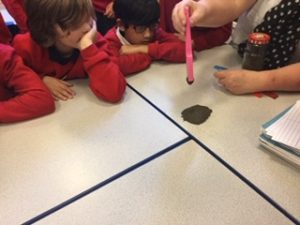
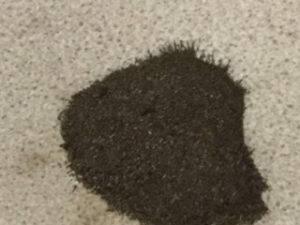
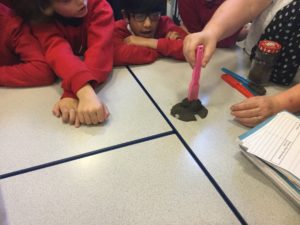
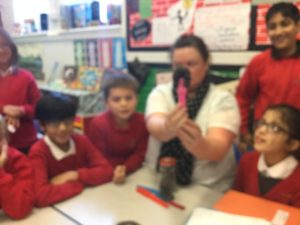
This got us thinking about whether or not the size of the magnet had an impact on it’s strength.
The class were asked to work scientifically to explore this. Using different sizes of magnets and paperclips, the children made predictions, tested magnet, recorded their findings and were then able to decide if size made a difference to strength. One rule was that paperclips were NOT allowed to be joined!
The bigger the magnet, the stronger the force?

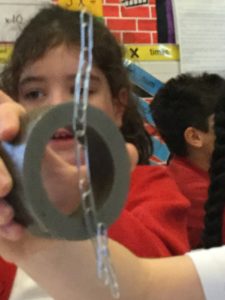
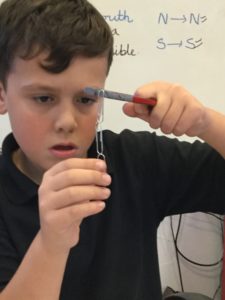
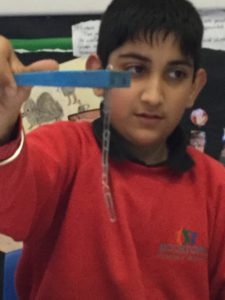

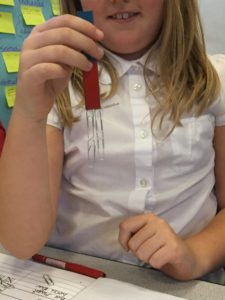
The children were not shown how to carry out the experiment. I was really impressed with how they set about testing the magnets. All around the room it was great to hear some fantastic, scientific conversations taking place. They will be studying their findings in our next lesson.
“Let’s work slowly and add one paperclip at a time.” Devising a systematic approach!
Here are a few magnet activities for at-home learning:
Visit the library and look for information books on magnets.
Investigate how many paper-clips you can pick up with different magnets.
Explore magnets: what do they stick too? What items are magnetic? This could be around the house or outside around your local environment.
Do you have any magnets around the house? What are they used for? Can you investigate different uses for magnets?
Find out about how electricity and magnetism are linked.
Make your own fridge magnets and decorate them in any way you like.
What is a force?
This week, Year 3 have been introduced to their new mini topic – ‘Forces.’
Did you know that without forces our world would be silent and immobile?
The lessons began with the children recognising that everything on Earth is powered by forces, pushes and pulls which act on our bodies and the things around us. Forces make things move and stop moving.
Having discussed pushing and pulling, it was time to demonstrate these forces using our bodies. Working with a partner, the children created their own push and pull forces. Some were easier than others!


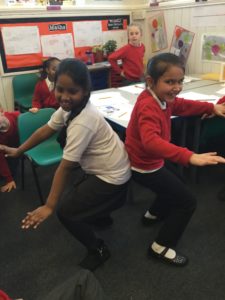
Magnetism
Before some experimental learning, we discussed magnets and named different types. The children were fascinated to see what happens when a magnet gets close to a magnetic object.
A magnet can move an object without touching it.
Using iron filings, we tested different magnets to see if this was true.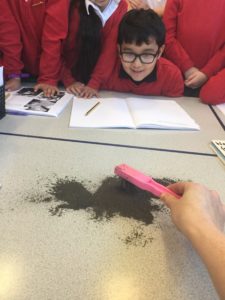
Magnetism is an invisible force. A magnet attracts or repels other items. Magnets have north poles and south poles. These attract each other. But two north poles will repel each other, as will two south poles.
Iron is magnetic, so any metal with iron in it will be attracted to a magnet. Most other metals, like aluminium, copper or gold, are not magnetic.
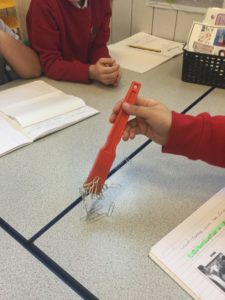
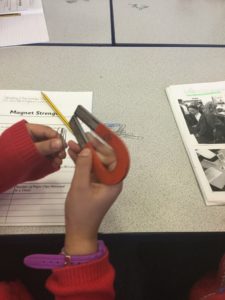
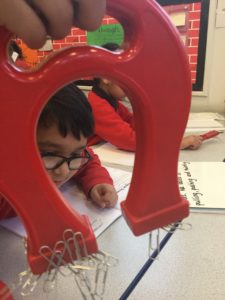
With forces in mind, Year 3 put these into action in their Bollywood PE lesson.
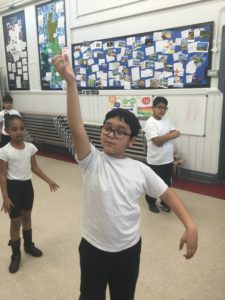
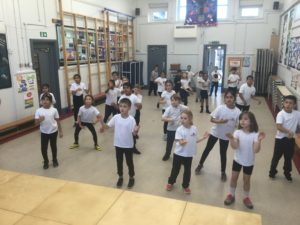

by Mrs Burgess
Topic Review
To review the learning that we did in our recent big topic, ‘Time Travel’, we mixed up the classes. We mixed classes with Year 3 and talked with them about the great learning that was in our books and in theirs. We then fed back about pieces of learning that we particularly liked.

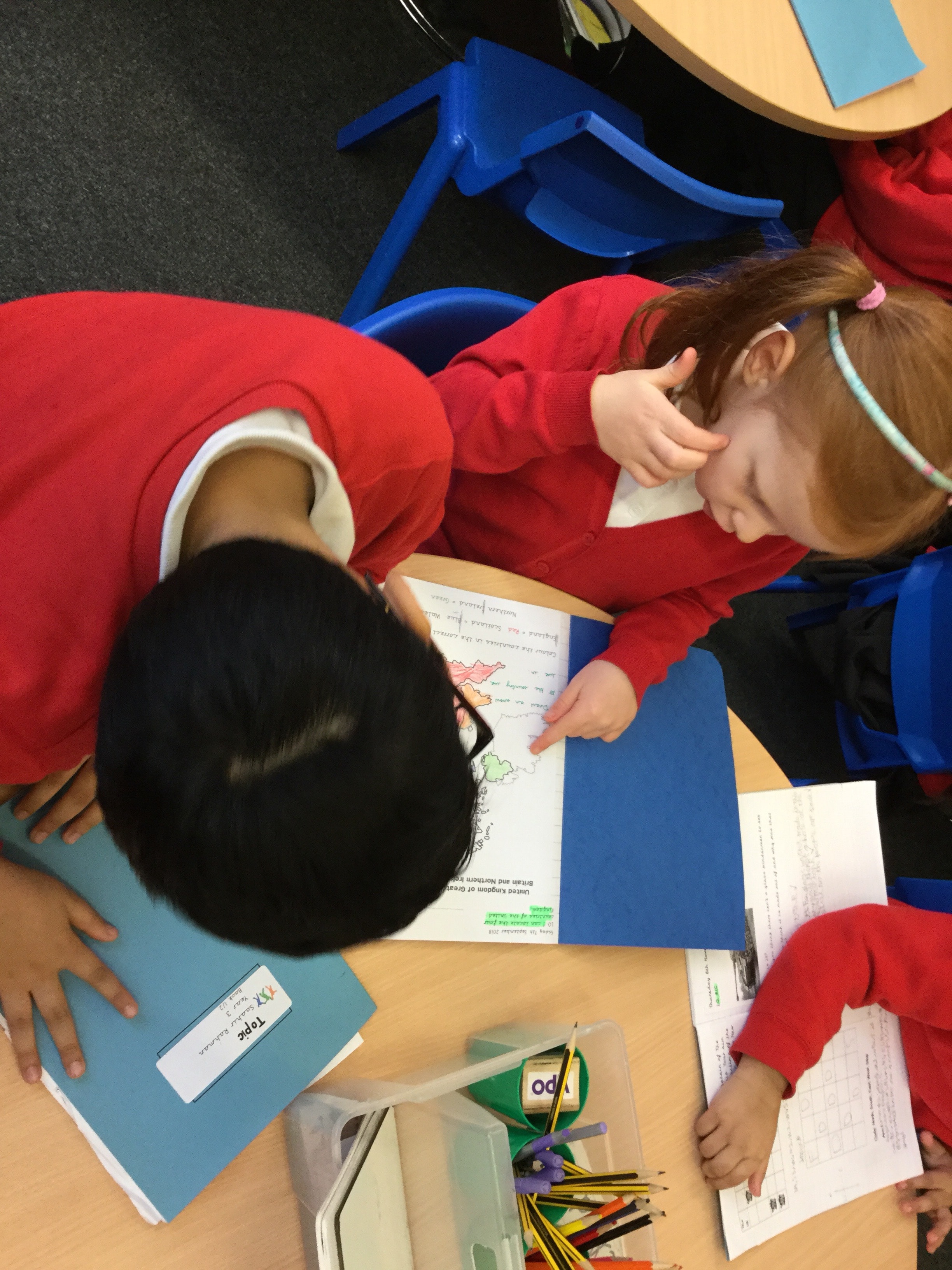

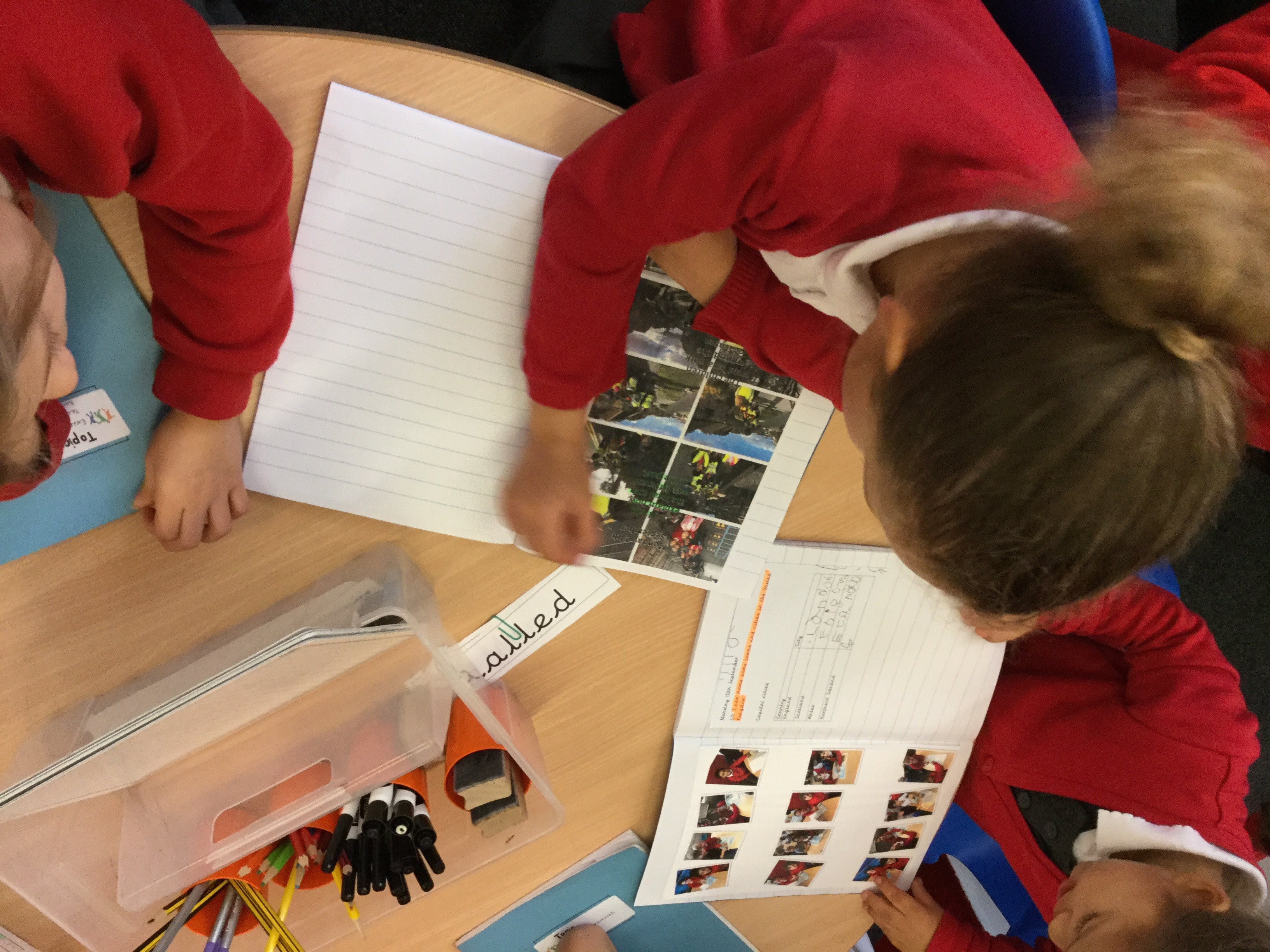

Mindful Writing
Check how peaceful our writing is. Children are describing their own lands – both weird and wonderful – that they have drawn earlier in the week.
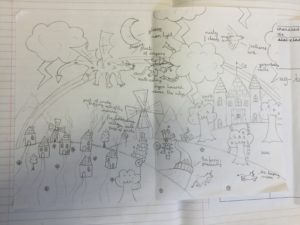
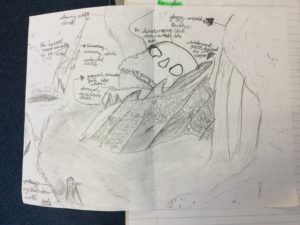
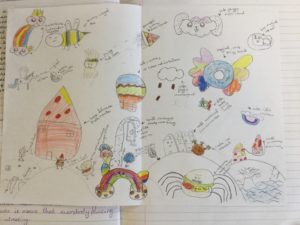
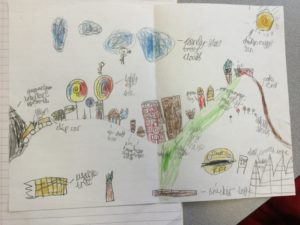
I’m looking forward to reading them!
Great Assembly
Well done to all of Year 3 for a super assembly today. The children spoke clearly and with such confidence. We all enjoyed the ‘Guess Who‘ game too!
Thank you to all who came to watch the assembly. We hope you enjoyed it as much as we did!
Descriptive, Creative Writing
Some great examples of narrative writing typed up for Class News by Henka and Liam.
Dobby the Brave
by Henka
One miserable evening, the elves were gathered in the palace on top of the toadstool blundering about Fenris and what to do with the powerful, massive wolf. They figured that they needed a magical rope, forged by goblins, to tie Fenris up. A shrill voice broke the silence: “Let me go! I will get the rope and trap the mighty wolf!”. Dobby’s voice broke the sullen silence. Although Dobby barely had anything to help him except a hat, that allowed him to fly and a wrankin, a race of animals that have parts of different creatures – elephant, unicorn, snake, T-Rex, werewolf and sabre-toothed tiger. Although it is dangerous, it is quite gentle. Dobby ran out of the castle and set off to find the rope.
Dobby travelled far and wide looking for the golden rope. He passed valleys, crossed rivers and walked through deserts. When walking, he encountered villagers who pressed juicy plums and long baguettes into his cold and shaky hands. He ate these contentedly and carried on his journey. When they reached Neilfam, the home of frost giants and a really cold, windy and snowy place, was when Wig loses Dobby’s hat. He blew out his trunk which made the magical hat fly away and Dobby plummeted to the ground! Wig just managed to save his master but the hat was nowhere to be seen. Dobby sat and cried and cried and cried until he had no more tears to cry.
Crump and Wadela’s Adventure
by Liam
One freezing cold night, the fierce warriors met in their ruined house to make a plan to defeat the evil, ugly goblins. The warriors angrily and loudly discussed a plan.
In angry voices, the other warriors said Crump should go and get the diamond, shimmering crystal. Crump felt scared. But he wanted to see the crystal first, so he snatched Wadela’s hands and set off nervously. Crump walked through the gloomy, damp forest with his four-legged, horn-headed friend. For the next two days, they travelled across swing bridges, over steep mountains, shadowy lakes and icy rivers. As they travelled, people pressed smelly cheese, brown crusty bread and clear water into hands.
KS1 cricket
Thank you to Tom Bates from Yorkshire Cricket who delivered great, fun cricket skills sessions yesterday for Year 1 and 2.
The sessions were to promote the All Stars cricket programme that will be available in 2019. Preregister on their website to receive details of how your child can take part in the sessions due to be held at local cricket clubs next year.
This video gives more information about All Stars cricket.
